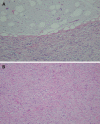Intraperitoneal dedifferentiated liposarcoma: a case report
- PMID: 18855997
- PMCID: PMC2751908
- DOI: 10.3748/wjg.14.5927
Intraperitoneal dedifferentiated liposarcoma: a case report
Abstract
Dedifferentiated liposarcoma is a variant of liposarcoma with a more aggressive course. Mutations of the p53 gene have been found in different types of soft tissue sarcoma. It is generally accepted that p53 mutations in human malignant tumors are often related to a poor prognosis. In our case, analysis of p53 gene mutation in tumor samples was performed. p53 gene mutation was observed in dedifferentiated tumor tissue samples but not in well-differentiated tumor tissue samples. It has been reported that p53 gene mutation occurs most commonly in the retroperitoneum and rarely in other anatomic locations. Herein we report a case of dedifferentiated liposarcoma located at intraperitoneum.
Figures



Similar articles
-
Intraperitoneal dedifferentiated liposarcoma showing MDM2 amplification: case report.World J Surg Oncol. 2013 Nov 26;11:305. doi: 10.1186/1477-7819-11-305. World J Surg Oncol. 2013. PMID: 24279301 Free PMC article.
-
Molecular and immunohistochemical p53 status in liposarcoma and malignant fibrous histiocytoma: identification of seven new mutations for soft tissue sarcomas.Cancer. 1995 Oct 1;76(7):1187-96. doi: 10.1002/1097-0142(19951001)76:7<1187::aid-cncr2820760714>3.0.co;2-4. Cancer. 1995. PMID: 8630896
-
H-ras oncogene mutation in dedifferentiated liposarcoma. Polymerase chain reaction-restriction fragment length polymorphism analysis.Am J Clin Pathol. 2001 Feb;115(2):235-42. doi: 10.1309/HEF7-54YQ-JUVE-2THH. Am J Clin Pathol. 2001. PMID: 11211612
-
Update on genomic and molecular landscapes of well-differentiated liposarcoma and dedifferentiated liposarcoma.Mol Biol Rep. 2021 Apr;48(4):3637-3647. doi: 10.1007/s11033-021-06362-5. Epub 2021 Apr 24. Mol Biol Rep. 2021. PMID: 33893924 Review.
-
MDM2+/CDK4+/p53+ oral liposarcoma: case report and review of the literature.Oral Surg Oral Med Oral Pathol Oral Radiol Endod. 2001 Aug;92(2):194-201. doi: 10.1067/moe.2001.116815. Oral Surg Oral Med Oral Pathol Oral Radiol Endod. 2001. PMID: 11505267 Review.
Cited by
-
Dedifferentiated liposarcoma of the small bowel mesentery presenting as a submucosal mass.World J Gastrointest Oncol. 2011 Jul 15;3(7):116-8. doi: 10.4251/wjgo.v3.i7.116. World J Gastrointest Oncol. 2011. PMID: 21860688 Free PMC article.
-
Intraperitoneal Liposarcoma: A Case Report and Literature Review of a Rare Entity.Cureus. 2024 Apr 28;16(4):e59244. doi: 10.7759/cureus.59244. eCollection 2024 Apr. Cureus. 2024. PMID: 38813304 Free PMC article.
-
Multiple Primary Dedifferentiated Liposarcoma of the Jejunal Mesentery: A Case Report and Review of Literature.J Clin Diagn Res. 2016 Jan;10(1):XD01-XD04. doi: 10.7860/JCDR/2016/15009.7090. Epub 2016 Jan 1. J Clin Diagn Res. 2016. PMID: 26894164 Free PMC article.
-
Giant dedifferentiated liposarcoma of small bowel mesentery: a case report.World J Surg Oncol. 2016 Sep 21;14(1):250. doi: 10.1186/s12957-016-1007-1. World J Surg Oncol. 2016. PMID: 27654578 Free PMC article.
-
Primary small bowel liposarcoma (atypical lipomatous tumour) with myogenic differentiation.Sarcoma. 2010;2010:807981. doi: 10.1155/2010/807981. Epub 2010 Jul 26. Sarcoma. 2010. PMID: 20706648 Free PMC article.
References
-
- Fletcher CDM, Unni KK, Mertens F. World Health Organization Classification of Tumors. Pathology and Genetics of Tumours of soft tissue and bone. Lyon: IARC Press; 2002. pp. 40–44, 227-232.
-
- Ichikawa A, Kinoshita T, Watanabe T, Kato H, Nagai H, Tsushita K, Saito H, Hotta T. Mutations of the p53 gene as a prognostic factor in aggressive B-cell lymphoma. N Engl J Med. 1997;337:529–534. - PubMed
-
- de Anta JM, Jassem E, Rosell R, Martínez-López E, Jassem J, Monzó M, Sánchez-Hernández JJ, Moreno I, Sánchez-Céspedes M. TP53 mutational pattern in Spanish and Polish non-small cell lung cancer patients: null mutations are associated with poor prognosis. Oncogene. 1997;15:2951–2958. - PubMed
-
- Taubert H, Meye A, Wurl P. Prognosis is correlated with p53 mutation type for soft tissue sarcoma patients. Cancer Res. 1996;56:4134–4136. - PubMed
-
- Drobnjak M, Latres E, Pollack D, Karpeh M, Dudas M, Woodruff JM, Brennan MF, Cordon-Cardo C. Prognostic implications of p53 nuclear overexpression and high proliferation index of Ki-67 in adult soft-tissue sarcomas. J Natl Cancer Inst. 1994;86:549–554. - PubMed
Publication types
MeSH terms
Substances
LinkOut - more resources
Full Text Sources
Medical
Research Materials
Miscellaneous

